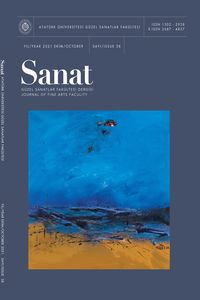Öz
The human needs an “other” to bring herself/himself into existence as a “I” in her/his world. The being to which the “I” compares itself needs to have similar emotional and behavioral skills, as well. Thus, animals, the closest creatures to human beings in the nature, are positioned as an “other” to be encountered by the “I”. The purpose of this study is to investigate the situations in which animal takes place as the ‘other’ of human in the ‘I’ installation of the subject that is human and to examine the reflections of the questionings made with philosophical thinkings on art history. The first section of the study will examine how humans separated themselves from animals that they coexist in the nature and the rise of the human-animal dualism as from the Ancient Greek. The second section will investigate the construction of the ‘I’ fiction on the basis of the philosophies of Maurice Merleau-Ponty, Emanuel Levinas and Jacques Lacan and the necessity of the ‘other’ in this fiction. The third section will assess the reflections of the questionings about the human-animal relationship, which is the subject of the study, on art. The assessments will focus on the concepts of meat and body, paintings by Rembrandt and Francis Bacon, Emanuel Levinas’ ‘I’ ‘having a face’ that is expressed as a means of knowing the ‘other’, Kate Clark’s statues, Merleau-Ponty’s idea of an intersubjective world created between humans and animals and Joseph Beuys and Oleg Kulik’s performances.
Kaynakça
- Agamben, G. (2012). ‘’Açıklık- İnsan ve Hayvan’’ (Çev. M. M. Çilingiroğlu). İstanbul: Yapı Kredi Yayınları.
- Aristoteles. (2018). ‘’Ruh Üzerine’’ (Çev. Ö. Aygün, Y.G. Sev). İstanbul: Pinhan Yayıncılık.
- Berger, J. (2017). ‘’Hayvanlara Niçin Bakarız’’ ( Çev. C. Çapan). İzmir: Tudem Yayın Grubu.
- Candil Erdoğan, F. (Ed.). (2016). ‘’Rembrandt’’. İstanbul: Hayalperest Yayınevi.
- Descartes. (2013). ‘’Metot üzerine Konuşma’’ (Çev. A. Timuçin, Y. Tümuçin). İstanbul: Paradigma Yayıncılık.
- Eroğlu, Ö. (2018). ‘’Yeni Modern Francis Bacon’’. İstanbul: Tekhne Yayınları.
- Erzen, J. (2011). ‘’Çoğul Estetik’’. İstanbul: Metis Yayıncılık.
- Gökyaran, E. (2003). ‘’Başkası ve Aşkınlık’’. Z.Direk (Ed.). Dünyanın Teni (s:45-79). İstanbul: Metis Yayınları.
- Lacan, J. (1982). ‘’<<Özne-Ben>>in İşlevinin Oluşturucusu Olarak Ayna Evresi’’ (Çev. N. Kuyaş). Selahattin Hilav (Haz.). Yazko
- Felsefe Yazıları. S1. 149-156. İstanbul: Yazko Yayınları.
- Leppert, R. (2009). ‘’Sanatta Anlamın Görüntüsü’’ (Çev. İ. Türkmen). İstanbul: Ayrıntı Yayınları.
- Merleau-Ponty, M. (2016). ‘’Algının Fenomenolojisi’’ (Çev. E. Sarıkartal, E. Hacımuratoğlu). İstanbul: İthaki Yayınları.
- Merleau-Ponty, M. (2017). ‘’Algılanan Dünya’’ (Çev. Ö. Aygün). İstanbul: Metis yayınları.
- Merdaner, E. (2016). ‘’Joseph Beuys Sanatı ve Felsefesine Bir Bakış’’. İstanbul: Tekhne Yayınları.
- Read, H. (2017). ‘’Sanatın Anlamı’’ (Çev. N. Asgari). İstanbul: Hayalperest Yayınevi.
- Ryan, D. (2019). ‘’Hayvan Kuramı’’ (Çev. A. Alkan,). İstanbul: İletişim Yayınları.
- Simondon, G. (2019). ‘’Hayvan ve İnsan Üzerine İki Ders’’ (Çev. E. Sünter). İstanbul: Norgunk Yayıncılık.
- Soyşekerci, S. (2015). ‘’Beden Sanatı’’. Ankara: Doğu Batı Yayınları.
- Şimşon, E. (2015). ‘’Levinas ve Bobby Bir Köpeğin Levinas’ın Etiğindeki Rolü’’. Cogito. S80. 37-51.
Öz
İnsan, kurduğu dünyada kendini ‘ben’ olarak var edebilmek için, bir ‘başka’ya ihtiyaç duymaktadır. ‘Ben’in, kendini karşılaştıracağı varlığın da onun gibi duygu ve davranış becerilerine sahip olması gerekmektedir. Bu nedenle, doğada insana en yakın varlık olan hayvan, ‘ben’in karşılaşacağı ’başka’ olarak konumlanmaktadır. Bu çalışmanın amacı, insan olan öznenin ‘ben’ kurulumunda hayvanın, insanın ‘başka’sı olarak yer aldığı durumları araştırmak ve felsefi düşünceler ile yapılan sorgulamaların, sanat tarihine yansımalarını incelemektir. Çalışmanın ilk bölümünde, doğada birlikte var olduğu hayvandan, insanın kendini nasıl ayırdığı ve insan-hayvan arasında yaratılan ikiliğin ortaya çıkışı, Antik Yunan’dan itibaren incelenecektir. İkinci bölümde Maurice Merleau-Ponty, Emanuel Levinas ve Jacques Lacan’ın felsefeleri üzerinden ‘ben’ kurgusunun yapılışı ve bu kurguda ‘başka’nın gerekliliği araştırılacaktır. Üçüncü bölümde ise inceleme konusu olan insan-hayvan ilişkisi üzerine sorgulamaların sanata yansımaları değerlendirilecektir. Değerlendirmeler, et ve beden kavramları ile Rembrandt ve Francis Bacon’un resimlerini, Emanuel Levinas tarafından ‘ben’in, karşısındakini tanıma aracı olarak ifade edilen ‘yüze sahip olma’ durumu ile Kate Clark’ın heykellerini ve Merleau-Ponty’nin, insan ve hayvan arasında yarattığı öznelerarası dünya fikri ile Joseph Beuys ve Oleg Kulik’in performanslarını ele alacaktır.
Kaynakça
- Agamben, G. (2012). ‘’Açıklık- İnsan ve Hayvan’’ (Çev. M. M. Çilingiroğlu). İstanbul: Yapı Kredi Yayınları.
- Aristoteles. (2018). ‘’Ruh Üzerine’’ (Çev. Ö. Aygün, Y.G. Sev). İstanbul: Pinhan Yayıncılık.
- Berger, J. (2017). ‘’Hayvanlara Niçin Bakarız’’ ( Çev. C. Çapan). İzmir: Tudem Yayın Grubu.
- Candil Erdoğan, F. (Ed.). (2016). ‘’Rembrandt’’. İstanbul: Hayalperest Yayınevi.
- Descartes. (2013). ‘’Metot üzerine Konuşma’’ (Çev. A. Timuçin, Y. Tümuçin). İstanbul: Paradigma Yayıncılık.
- Eroğlu, Ö. (2018). ‘’Yeni Modern Francis Bacon’’. İstanbul: Tekhne Yayınları.
- Erzen, J. (2011). ‘’Çoğul Estetik’’. İstanbul: Metis Yayıncılık.
- Gökyaran, E. (2003). ‘’Başkası ve Aşkınlık’’. Z.Direk (Ed.). Dünyanın Teni (s:45-79). İstanbul: Metis Yayınları.
- Lacan, J. (1982). ‘’<<Özne-Ben>>in İşlevinin Oluşturucusu Olarak Ayna Evresi’’ (Çev. N. Kuyaş). Selahattin Hilav (Haz.). Yazko
- Felsefe Yazıları. S1. 149-156. İstanbul: Yazko Yayınları.
- Leppert, R. (2009). ‘’Sanatta Anlamın Görüntüsü’’ (Çev. İ. Türkmen). İstanbul: Ayrıntı Yayınları.
- Merleau-Ponty, M. (2016). ‘’Algının Fenomenolojisi’’ (Çev. E. Sarıkartal, E. Hacımuratoğlu). İstanbul: İthaki Yayınları.
- Merleau-Ponty, M. (2017). ‘’Algılanan Dünya’’ (Çev. Ö. Aygün). İstanbul: Metis yayınları.
- Merdaner, E. (2016). ‘’Joseph Beuys Sanatı ve Felsefesine Bir Bakış’’. İstanbul: Tekhne Yayınları.
- Read, H. (2017). ‘’Sanatın Anlamı’’ (Çev. N. Asgari). İstanbul: Hayalperest Yayınevi.
- Ryan, D. (2019). ‘’Hayvan Kuramı’’ (Çev. A. Alkan,). İstanbul: İletişim Yayınları.
- Simondon, G. (2019). ‘’Hayvan ve İnsan Üzerine İki Ders’’ (Çev. E. Sünter). İstanbul: Norgunk Yayıncılık.
- Soyşekerci, S. (2015). ‘’Beden Sanatı’’. Ankara: Doğu Batı Yayınları.
- Şimşon, E. (2015). ‘’Levinas ve Bobby Bir Köpeğin Levinas’ın Etiğindeki Rolü’’. Cogito. S80. 37-51.
Ayrıntılar
| Birincil Dil | Türkçe |
|---|---|
| Bölüm | Makaleler |
| Yazarlar | |
| Yayımlanma Tarihi | 28 Ekim 2021 |
| Gönderilme Tarihi | 7 Temmuz 2021 |
| Yayımlandığı Sayı | Yıl 2021 Sayı: 38 |

Bu eser Creative Commons Atıf-GayriTicari 4.0 Uluslararası Lisansı ile lisanslanmıştır.


